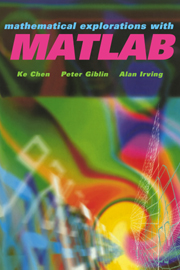Book contents
- Frontmatter
- Contents
- Preface
- Part one Foundations
- Part two Investigations
- Part three Modelling
- Appendix 1 MATLAB Command Summary
- Appendix 2 Symbolic Calculations within MATLAB
- Appendix 3 List of All M-files Supplied
- Appendix 4 How to Get Solution M-files
- Appendix 5 Selected MATLAB Resources on the Internet
- References
- Index
Preface
Published online by Cambridge University Press: 08 February 2010
- Frontmatter
- Contents
- Preface
- Part one Foundations
- Part two Investigations
- Part three Modelling
- Appendix 1 MATLAB Command Summary
- Appendix 2 Symbolic Calculations within MATLAB
- Appendix 3 List of All M-files Supplied
- Appendix 4 How to Get Solution M-files
- Appendix 5 Selected MATLAB Resources on the Internet
- References
- Index
Summary
Mathematics and its practitioners have come a long way since the days of drawing polygons in the sand with a stick. Although this cannot be said of all our degree courses, there is nevertheless an increasing realisation in higher mathematics education that current computing technology can open new doors for students and tutors alike. This book arose out of a largely successful attempt to complement traditional mathematical courses with one which took this opportunity seriously.
First year students at a UK university are expected to acquire a wide range of mathematical skills—the ability to argue logically, absorb new concepts, calculate accurately, translate everyday problems into appropriate mathematical language, construct mathematical models and to assess the approximations made. We chose to use the popular and powerful computer package MATLAB® to help promote some of these skills. It provided a convenient way to help students understand things graphically, to see the wood rather than the trees in complex problems and to give access to more realistic modelling situations.
We chose MATLAB rather than one of the increasingly sophisticated and algebraically based packages because of the very gently sloped learning curve involved. MATLAB allows the student to graduate smoothly from the functionality of a hand calculator, through increasing use of powerful numerical and graphical facilities towards a high level programming capability. The latter point was considered a bonus in that it provided a possible access route to programming for students with no prior computer background. At the very least, students with no keyboard skills at all can acquire a degree of familiarity with an essential modern tool, the computer.
Information
- Type
- Chapter
- Information
- Mathematical Explorations with MATLAB , pp. xi - xivPublisher: Cambridge University PressPrint publication year: 1999
